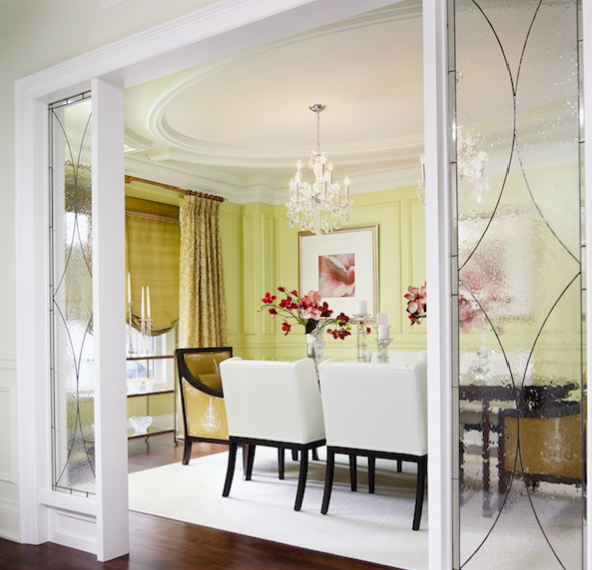It was three years after Ontario interior designer Regina Sturrock designed a luxury model house for a well-known builder—the scope of which entailed architectural detailing, millwork design and, as she puts it, “the finer points of interior design and decor”—when she discovered that another designer had been presenting the work as her own.

A real estate agent for the property informed Sturrock that another decorator was posting images of the home on Facebook and on her website, “actively promoting it all as her own work.” The designer in question, Sturrock says, had apparently decorated model homes for the same builder and had recently moved to the United States. “Perhaps she felt that distance and time would grant enough obscurity,” Sturrock surmises. She says the images were not from her own professional shoot and suspects they were taken during the open house.
She surveyed Facebook comments on the poser’s page, noting discrepancies; for one thing, the decorator claimed that the project had no budget. (In reality, Sturrock had painted several large canvases herself “to fill the walls” and also used some of her own collections to meet the project’s budget.)
It’s a common problem, but not an insurmountable one. Some cases are what New York attorney Alex Ross of Ross & Katz PLLC—who represents a range of commercial and residential designers—calls “pretty egregious.” File this one under that label: Photos of designer Tamara Magel, who works in the Hamptons and Palm Beach, were posted on another New York designer’s website. Magel says he entered those photos into a competition—which he won—and parlayed the success to become a brand ambassador for a high-end kitchen brand. She discovered her work on the man’s Houzz and Instagram profiles, and saw it won him a spot on a list of top African American designers back in 2015. “My work, his award,” she tells EAL.
“It’s a timely topic,” says Ross, who previously worked at Levy Sonet & Siegel LLP, a firm specializing in interior design clients. “It’s coming up more and more. People think that if they just download something from the internet, they can use it. But it’s not the case.” If your work has already been misused or misrepresented, he suggests speaking to your lawyer immediately. “Typically, a cease-and-desist letter should be issued,” he says.
Sturrock had done just that. “My actions were swift,” she says. Her lawyer advised her to seek justice via social media first. “I commented on each individual Facebook post, stating that our firm was the real owner of the work. Of course ... my comments were immediately removed. I also posted the theft on my social media channels.” She informed the copycat designer via email that she would take legal action “if all images of our work were not immediately removed from any and all platforms.” The designer contacted Sturrock the next morning, claiming that she had confused her work with Sturrock’s.
“I didn’t have the energy to argue the ridiculous explanation,” Sturrock, of Regina Sturrock Design, tells EAL. “I honestly feel quite sorry for this person who believed that it would serve her well to steal my work. Beyond the potential legal ramifications, it’s short-sighted to imagine that one can build a successful and respectable business on the footings of a lie. The design world is small!”
For Magel’s part, she first got wind of the deception in question when the designer (who she says previously worked for her, at her first store, in SoHo) attempted to do a New York showhouse, and shared photos with an acquaintance of Magel’s, who recognized the work. “It was very audacious, it was everywhere,” the designer says. She sprung to action first on social media and was met with mixed results. The designer she says infringed on her work was popular and often attended Manhattan events that she did not. “It goes to show that schmoozing goes a long way,” Magel reflects. “[At the time] I was thinking, Wow, I should just show up to all these events. But I’m in the business to get clients. I don’t need to have the industry to love me. But everybody loved him.”
 There’s certainly a difference between someone who takes some inspiration from a widely known designer and someone who takes a photo and submits it to a contest.” —Attorney Alex Ross
There’s certainly a difference between someone who takes some inspiration from a widely known designer and someone who takes a photo and submits it to a contest.” —Attorney Alex Ross
“The biggest thing was calling him out on social media,” she says, noting that she was met with many defending him. “But [my approaching him] was what really scared him.” She also got in touch with the designer competition and with the kitchen brand. The competition dissociated itself from him; she says the brand did not respond. (The designer did not respond to EAL’s requests for comment.)
Bottom line? Know thy enemy—actually, know if you truly have an enemy. “People make mistakes and sometimes they just don’t know about intellectual property and how important it is,” cautions Ross. “There’s certainly a difference between someone who takes some inspiration from a widely known designer and someone who takes a photo and submits it to a contest.”
Thanks to the Digital Millennium Copyright Act (DMCA), you can reach out directly to the copycat’s website host to inform them that the work is yours and should be taken down. “For example, someone takes an [image belonging to] one designer and puts it on her Houzz profile. That would be a take-down notice,” explains Ross. (Google “DMCA take-down notice” to find templates.)
In the case of a falsified contest entry, he says, there are a number of claims—among them, false designation and misrepresentation. Designers “could certainly seek financial compensation,” in some cases. If a designer were to sue someone who, for example, submitted work to a contest as his own when it was not, the affronted designer would have to prove, during the trial, her damages, such as “loss of revenue and whatever benefits the cheating designer got in terms of publication, publicity from winning the award, and [funds], if there was any monetary payment for winning the award.”
Ross also says he’d ask for an apology from the cheating designer. In one such case, a client’s website text was copied word for word on another designer’s site by “some intern-slash-cousin’s friend” working for the designer in Florida. Ross sent a cease-and-desist; the firm said it wasn’t aware, and ultimately paid Ross’s client’s legal fees—and delivered an apology. Given the right conditions, he explains, “I would definitely extract some kind of monetary settlement, because it is wrong. Without a penalty, they wouldn’t hesitate to do it again.”

Don’t have a lawyer? Consider getting one—perhaps preventatively. Robin Shaw, an Indianapolis attorney and editor who represents designers, authors and other creatives, says that the law as it relates to design is “very complex. Unlike a painting, which is a single work of art, interior designs are compilations of other works which are not currently protected by the law in the same way as other works of art, literature or music.” Having a lawyer on hand can, like a cease-and-desist, establish a designer’s authority. “Just knowing that you are represented by a lawyer lets others know that you are serious about protecting your work.”
Yet issues like these aren’t always black-and-white; occasionally, they can even work to a creator’s advantage. Ross points to one of his own recent cases: a wallpaper designer with a large social media following whose design was downloaded—by a prominent Instagrammer with an even larger social following—and printed onto a pair of pants. “It was great, because this woman has got one million followers. But we had to take a measured approach: ‘We appreciate that you like our product, but please don’t do that for any sales.’ You have to temper it to the recipient. If they’re not doing anything to confuse the public, and it’s really helpful to you, there’s a [productive] way you can respond.”
 The magic that occurs in the creative process can never be duplicated, ripped off or misrepresented.” —Designer Regina Sturrock
The magic that occurs in the creative process can never be duplicated, ripped off or misrepresented.” —Designer Regina Sturrock
Designers who have been through it share advice. “Always maintain professionalism and civility and cherish the brand you’ve developed,” says Sturrock. “I’ve seen some very unappealing rants and discords on social media, and quite frankly, they are ineffective in dealing with people who are dishonest and only serve to put all into one quagmire of disrespect. Your clients may very well be watching you! Take a few breaths and never react out of anger.”
While Magel found mixed reactions when sharing her story online, with some interior design group members defending her copycat, she did find an industry ally who supported her through the process; and Sturrock found support among her colleagues.
Shaw recommends the American Society of Interior Designers (ASID) as a resource, noting that the association is now at work on advocacy efforts “to gain greater protection” for interior designers throughout the U.S.
Eight years after her debacle, Sturrock says she’s still receiving positive feedback on the project that had once been ripped off. “The most wonderful end result was a handwritten thank-you letter by the family who had moved into the home. They thanked us for our creativity, our attention to the special details, and for the functionality that made their home ‘just right,’” she recalls. “The magic that occurs in the creative process can never be duplicated, ripped off or misrepresented.”
Photos courtesy Carole and Roy Timm Photography.




























